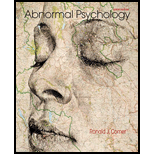
Introduction
Insanity, in layman terms, is explained as any behavior which seems abnormal, strange, and bizarre. Nietzsche's quotation is a reflection of the idea that an individual, on his own, may not engage in strange and reckless behavior. However, the same person can acquire the propensity to become wild and uncontrolled when he becomes involved in a group.
Explanation of Solution
Suggested response
The quotation by Neitzsche might suggest that how an individual behaves in privacy may be very different from how they behave in the presence of other people. This is also similar to the concept of de-individuation, which is studied by social psychologists. This concept states that the individual tends to get easily influenced by becoming part of a group. They lose their awareness and identity by gaining anonymous inclusion in the group. When people become a part of large groups, they do not feel responsible for their actions and therefore feel freer to engage in reckless and dangerous behavior.
Mob riots, mass homicide, mass hysteria, and terrorist organizations are all examples of how insanity or reckless behavior becomes extreme and dangerous when people come together.
Want to see more full solutions like this?
Chapter 14 Solutions
Abnormal Psychology
- This unit is designed to introduce students to the principles of community psychology and examine local issues through a lens of social determinants of health. Students will explore varieties of community issues such as homelessness, substance abuse, visible and invisible disabilities, and the public health crisis of racism. By analyzing the ways in which SDH intersects with both physical and mental health, both in their own communities and in differing communities, students will understand how social inequities can significantly impact the overall health of a population. Short Description This activity explores how inequality has both physical and psychological impacts on the individual and the community's health. Students will use a step-by-step analysis of SDH around the world. Instructions Using the unit readings, review the Social Determinants of Health: Public Health Agency of Canada. (2020, October 7). Social determinants of health and health and health inequalities. Government…arrow_forwardMatch the term with its description. Prompts Answers Prime Prime form started at a different pitch level Retrograde The original row Inversion Prime formed backward Transposition Original row with all intervals invertedarrow_forwardWrite an example of a peer evaluation. Instructions: Clarity and coherence of writing Depth of musical analysis Accuracy and relevance of observations Organization and structure of the report Grammar, spelling, and punctuation Originality of workarrow_forward
- Musical Interculturalism : Shakira - Waka Waka Instructions: Describe the cultural elements or influences present in the music and how they contribute to the overall sound and meaning. Discuss your personal connection or appreciation for this intercultural musical example. Reflect on how musical interculturalism enhances our understanding and appreciation of diverse cultural expressions through music.arrow_forwardWhat examples of musical interculturalism come to mind for you? Example: Shakira - Waka Waka Instructions: Describe the cultural elements or influences present in the music and how they contribute to the overall sound and meaning. Discuss your personal connection or appreciation for this intercultural musical example. Reflect on how musical interculturalism enhances our understanding and appreciation of diverse cultural expressions through music.arrow_forwardI need help finding 12 peer-reviewed articles on body modification that has to do with attractiveness with people with tattoos an those without tattoosarrow_forward
- Match a jazz style with its representative musician. Prompts Answers Progressive Jazz Poncho Sanchez Third Stream Gunther Schuller Fusion Stan Kenton Latin Jazz Miles Davisarrow_forwardMatch the subgenre with the short description. Prompts Answers Progressive Jazz A style that combines elements of jazz and classical music Fusion A subgenre of Latin Jazz that incorporates elements of Brazilian samba Bossa Novia A style that combines hip hop and jazz Jazz Rap A style that, in the 1970s and 1980s, integrated elements of Jazz and Rockarrow_forward12-tone composers: (Mark all that apply) 1) Stressed dissonance and fragmentation 2) Avoided a tonal center 3) Favored extensive programmatic works 4) Created angular and disjointed melodiesarrow_forward
- Gershwin’s famous composition Rhapsody in Blue uses: (Mark all that apply) 1) Jazz-like rhythms 2) Extended brass sections 3) A clarinet slide 4) References to the bluesarrow_forwardEnslaved Africans fought as if they were dancing as a form of physical training and preparation for uprisings. a) True b) Falsearrow_forwardSelect all the music characteristics of Bebop. 1) Music with complex harmonies and unpredictable rhythms. 2) Played by small jazz groups. 3) Meant for listening not dancing. 4) Played marking down the streets.arrow_forward
 Ciccarelli: Psychology_5 (5th Edition)PsychologyISBN:9780134477961Author:Saundra K. Ciccarelli, J. Noland WhitePublisher:PEARSON
Ciccarelli: Psychology_5 (5th Edition)PsychologyISBN:9780134477961Author:Saundra K. Ciccarelli, J. Noland WhitePublisher:PEARSON Cognitive PsychologyPsychologyISBN:9781337408271Author:Goldstein, E. Bruce.Publisher:Cengage Learning,
Cognitive PsychologyPsychologyISBN:9781337408271Author:Goldstein, E. Bruce.Publisher:Cengage Learning, Introduction to Psychology: Gateways to Mind and ...PsychologyISBN:9781337565691Author:Dennis Coon, John O. Mitterer, Tanya S. MartiniPublisher:Cengage Learning
Introduction to Psychology: Gateways to Mind and ...PsychologyISBN:9781337565691Author:Dennis Coon, John O. Mitterer, Tanya S. MartiniPublisher:Cengage Learning Psychology in Your Life (Second Edition)PsychologyISBN:9780393265156Author:Sarah Grison, Michael GazzanigaPublisher:W. W. Norton & Company
Psychology in Your Life (Second Edition)PsychologyISBN:9780393265156Author:Sarah Grison, Michael GazzanigaPublisher:W. W. Norton & Company Cognitive Psychology: Connecting Mind, Research a...PsychologyISBN:9781285763880Author:E. Bruce GoldsteinPublisher:Cengage Learning
Cognitive Psychology: Connecting Mind, Research a...PsychologyISBN:9781285763880Author:E. Bruce GoldsteinPublisher:Cengage Learning Theories of Personality (MindTap Course List)PsychologyISBN:9781305652958Author:Duane P. Schultz, Sydney Ellen SchultzPublisher:Cengage Learning
Theories of Personality (MindTap Course List)PsychologyISBN:9781305652958Author:Duane P. Schultz, Sydney Ellen SchultzPublisher:Cengage Learning





